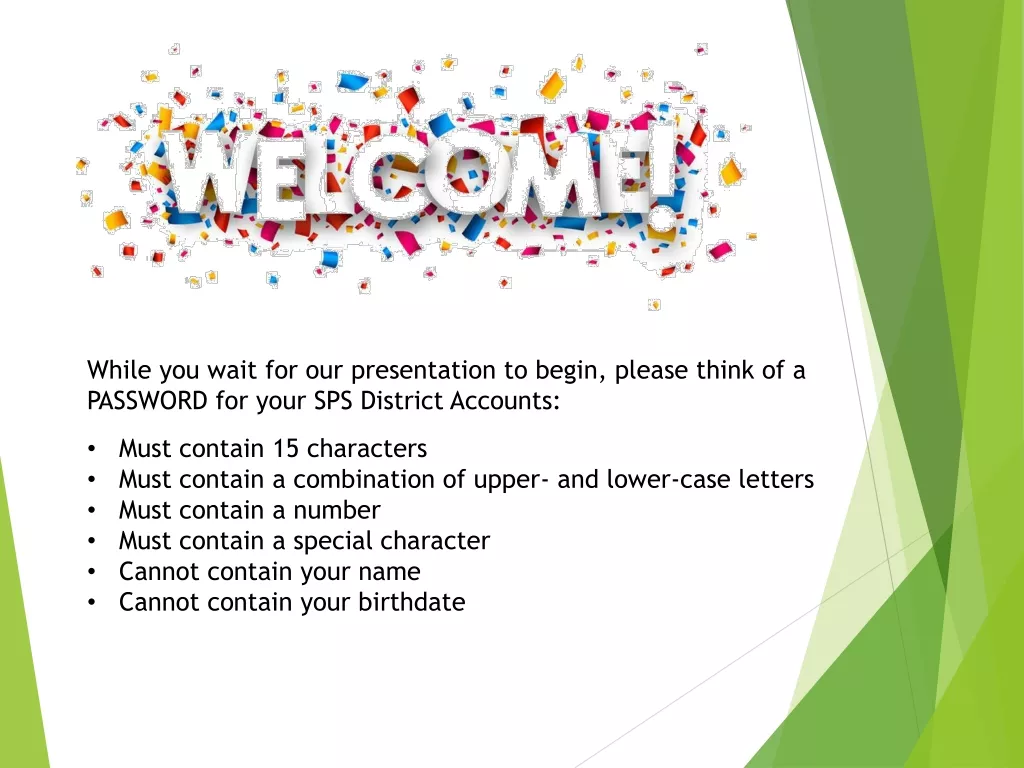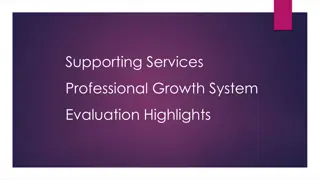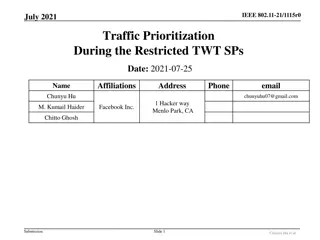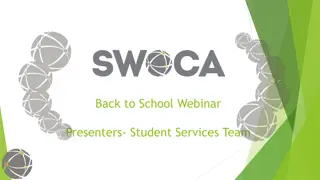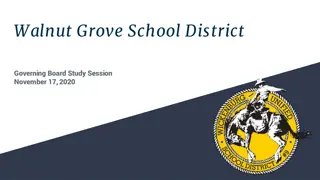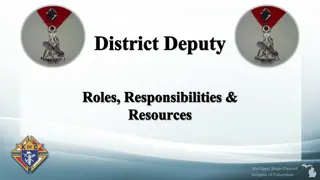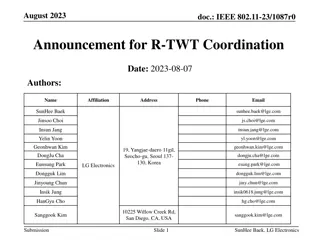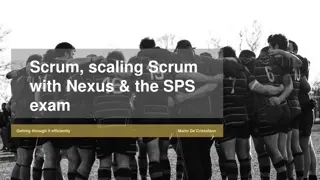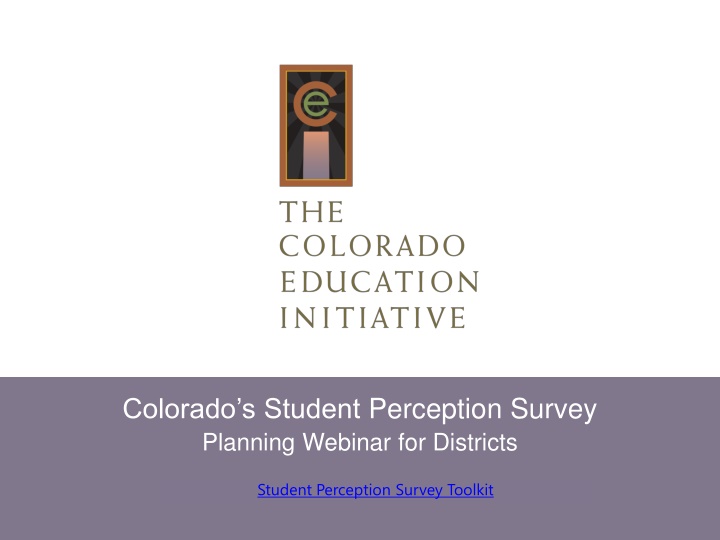
Enhancing Classroom Practices with Student Perception Surveys
Explore the benefits of utilizing student perception surveys to gain actionable feedback for schools and districts. Learn how these surveys provide valuable insights into classroom practices and student experiences, ultimately enhancing teaching effectiveness.
Uploaded on | 2 Views
Download Presentation

Please find below an Image/Link to download the presentation.
The content on the website is provided AS IS for your information and personal use only. It may not be sold, licensed, or shared on other websites without obtaining consent from the author. If you encounter any issues during the download, it is possible that the publisher has removed the file from their server.
You are allowed to download the files provided on this website for personal or commercial use, subject to the condition that they are used lawfully. All files are the property of their respective owners.
The content on the website is provided AS IS for your information and personal use only. It may not be sold, licensed, or shared on other websites without obtaining consent from the author.
E N D
Presentation Transcript
Colorados Student Perception Survey Planning Webinar for Districts Student Perception Survey Toolkit
AGENDA Survey overview Planning timeline Engaging stakeholders Key decision points Developing a communication strategy Data collection Survey Administration Preparing reports Distributing results
WHY USE A STUDENT PERCEPTION SURVEY? The survey is a unique form of actionable feedback that districts, schools and teachers can use to inform practice. Students are in unique position to contribute to a comprehensive view of classroom practice because they experience it more than anyone else in the education system. Student perception data can offer a big- picture view of what is happening in classrooms as well as school- and district-wide trends.
WHAT THE RESEARCH SAYS The Measures of Effective Teaching (MET) Project had two significant findings around student perception surveys: When student surveys are combined with observation and student growth data, these three measures tell us more and are able to predict future effectiveness better than any of them alone. Student perception survey results are correlated to student achievement gains. The use of student feedback has also been shown to promote both reflection and responsibility on the part of the students. Research Overview Bill and Melinda Gates Foundation (2012). Asking students about teaching: Student perception surveys and their implementation. (MET Project Policy and Practice Brief). Retrieved from http://www.metproject.org/downloads/Asking_Students_Practitioner_Brief.pdf Wiggins, G. (2011). Giving students a voice: The power of feedback to improve teaching. Education Horizons, 89(3), 23-26.
COLORADOS STUDENT PERCEPTION SURVEY 34-item survey asking a teacher s students about their learning experiences Two versions of the survey, grades 3-5 and grades 6-12 Developed by the Colorado Education Initiative Piloted in 16 Colorado districts representing a range of diversity Rigorous analyses confirm that the survey is fair, valid, and reliable The survey maps to Colorado s Teacher Quality Standards Survey measures elements of student experience that have been demonstrated to correlate most closely to student growth Full Technical Report
WHAT DOES THE SURVEY MEASURE? Student Learning How teachers use content and pedagogical knowledge to help students learn, understand, and improve. Standards I and III Student-Centered Environment How teachers create an environment that responds to individual students backgrounds, strengths, and interests. Standard II Classroom Community How teachers cultivate a classroom learning community where student differences are valued. Standard II Classroom Management How teachers foster a respectful and predictable learning environment. Standard II See the full surveys for grades 3-5 and 6-12
PLANNING TIMELINE Category Person Responsible Task At Least 3 Months Before Administration Appoint a district survey coordinator and a district planning committee. Make key decisions Determine communication strategy for staff, students, and community Start pulling needed student and teacher data for survey preparation. 2 Months Before Administration Start planning for survey administration with school leaders Start compiling materials such as surveys, building coordinator and proctor guides 1 Month Before Administration Let building coordinators know when their materials will arrive 2 Weeks Before Administration Deliver survey materials to schools Review survey materials Day(s) of Administration Deliver survey materials to proctors Directly After Administration Prepare survey materials for vendor or internal entry process 1-3 Months After Administration Planning Planning Planning Planning Superintendent Planning committee Planning committee District coordinator Planning Survey materials District coordinator District coordinator Communication District coordinator Survey materials District coordinator Survey materials Building coordinators: Administration Building coordinators Administration Building coordinators Communication Building and district coordinators Distribute reports and engage with staff on results Student Survey Planning Guide
ENGAGING STAKEHOLDERS Assign a survey coordinator Form a planning committee Chairperson: District survey coordinator District and building administrators Teachers District data staff member(s) Make key decisions
KEY DECISION: USE A VENDOR OR MANAGE ADMINISTRATION INTERNALLY? Take the following into account: Budget Internal capacity Other administration decisions Student Survey Planning Guide
KEY DECISION: ONLINE OR PAPER/PENCIL SURVEY ADMINISTRATION? Online Technology Paper/pencil Data entry Scheduling Scheduling Data quality Timeline Timeline Cost Cost
KEY DECISION: WHEN WILL SURVEY ADMINISTRATION TAKE PLACE? Recommended window is November January Also consider the following: Other testing windows School holidays and breaks The timeline for results
KEY DECISION: HOW WILL STUDENTS AND TEACHERS BE SAMPLED? Which teachers will participate? Sample size Scheduling How will students be sampled? At the secondary level, consider having a representative sample of students complete surveys for each teacher, rather than having all students complete surveys for all of their teachers At the elementary level students usually complete a survey for their homeroom teacher Students with disabilities Student Survey Planning Guide
KEY DECISION: HOW WILL SURVEY RESULTS BE USED? Consider a hold-harmless pilot year As a formative tool Reflect on practice, complete self-reflections, and create goals. Professional growth among colleagues Identify over-arching trends and create strategies to address them As a part of an evaluation Used as an artifact for determining ratings for professional practices Included as one of several multiple measures
KEY DECISION: HOW WILL SURVEY RESULTS BE USED? Sharing results Work with your teachers and association representatives to determine how teacher-level data will be shared Student Survey Planning Guide
DEVELOPING A COMMUNICATION STRATEGY: GUIDING PRINCIPLES By itself, a reliable and valid instrument does not ensure that teachers will receive good feedback Messaging matters Engage stakeholders early and often Make the process as transparent as possible Give stakeholders real decision-making power
DEVELOPING A COMMUNICATION STRATEGY: BUILDING EDUCATOR INVESTMENT Brief all instructional staff prior to survey administration Survey purpose Administration plans and timeline How results will be used Communication Tools for Teachers
Developing a Communication Strategy: Building student understanding Inform students of the survey in advance and to talk explicitly with them about the process and purpose It is essential for students to feel comfortable and respond honestly to survey items Student Information Sheet in English and Spanish
DEVELOPING A COMMUNICATION STRATEGY: INFORMING OTHER KEY STAKEHOLDERS Parents, school board members, and other community members should also be informed about the student survey purpose and process. Use the following resources to communicate with these stakeholders: o Drop-in articles o A sample parent letter in English and Spanish o Overview of Student Perception Surveys
DATA COLLECTION PRIOR TO ADMINISTRATION Assign a district point-person for data collection Relevant data Teacher ID numbers Student ID numbers Teacher, student, and course names Grade level and period Additional data Non-relevant data Data verification Data Checklist and Sample Data File
SURVEY ADMINISTRATION Customize materials to reflect key decisions: Protocols and instructions Survey materials Ensure that students know their confidentiality is being maintained: Proctoring Receiving survey materials in a way that protects confidentiality Accommodations: Students with disabilities Other students who need accommodations
PREPARING REPORTS Ensuring data quality Data cleaning Confidentiality Including the open-ended question Aggregating data Mean score Percent favorable Report structure By the survey elements By individual question As an aggregate score of all questions
DISTRIBUTION OF RESULTS Timing If possible, release results on a day and time when teachers will have some alone-time to review and reflect Consider a gradual release of data Communication Share the timeline for report release with teachers, evaluators, coaches, etc. Using the results Have district- and school-level plans in place for professional development Resources for Engaging with Results
THE DISTRICT PLANNING TOOLKIT A comprehensive planning guide Communication tools for teachers, principals, parents, students, and other stakeholders Survey materials for online or paper/pencil administration Resources for engaging with results The full technical report from the survey pilot http://www.coloradoedinitiative.org/studentsurvey/
TEACHER REFLECTION AND COACHING TOOLKITS Tools to introduce the survey to teachers Instructional strategies for each survey item Resources for setting goals around survey results A guide for discussing results with teachers


